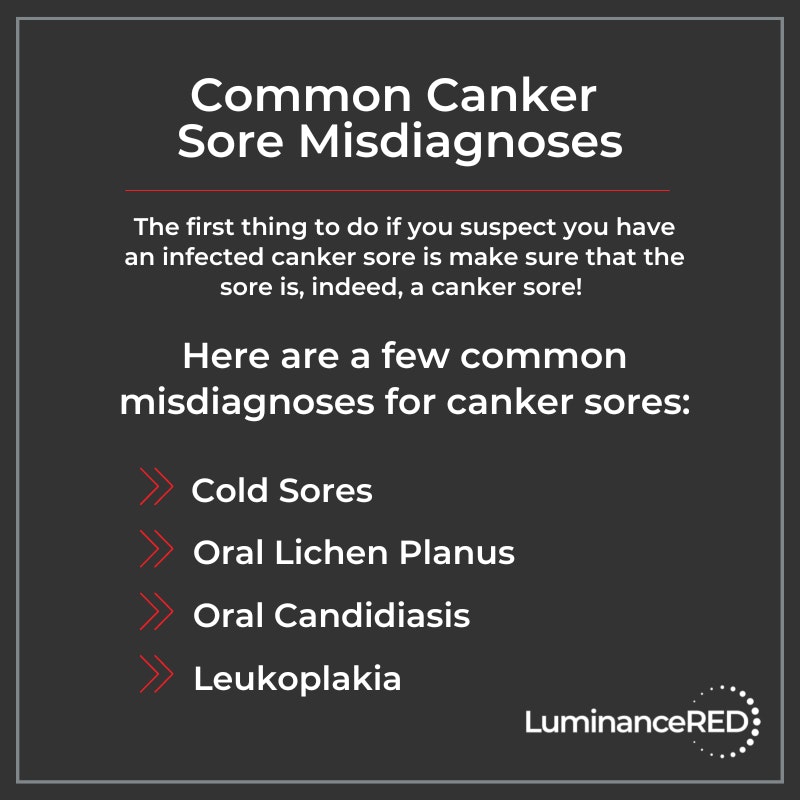Why Your Canker Sore (Probably) Isn’t Infected

Even under the best circumstances, canker sores — sometimes called cankers — are a real pain, and not just physically! These sensitive lesions are often sore and tender to the touch, and make everyday activities like eating, brushing your teeth, and even smiling too painful to bear.
When you’re in this much discomfort, you may ask yourself, “Do I have an infected canker sore?”
Keep scrolling to learn more about cankers, how to tell if yours is infected, and if so, what to do about it!

Is It a Canker Sore?
A canker sore is a common type of mouth ulcer. Sometimes referred to as aphthous ulcers, canker sores appear as shallow white or yellow lesions with a bright pink or red border.
Canker sores most commonly appear on the inside of the lips and cheeks, though they can also affect other parts of the mouth with soft tissues, such as the gums, uvula, tongue, or roof of the mouth. Cankers usually measure between one and four millimeters in diameter, though some can grow larger.
It’s important to note these painful sores are not contagious, and unlike cold sores, they aren’t caused by an infection from a herpes simplex virus. Canker sores have various triggers, which differ from person to person.
Common triggers for canker sores include:
- Excessive use of nonsteroidal anti-inflammatory drugs (NSAIDs), such as Motrin and Aleve
- Low levels of vitamin B12, folic acid, or iron
- The start of the menstrual cycle
- High-acid foods, such as oranges, tomatoes, and unripe bananas
- Certain autoimmune conditions
- Chronic stress
- Friction on the gums from braces or other orthodontic appliances
- Smoking
Common Canker Sore Misdiagnoses
Do you suspect you have a canker sore? Let’s make sure. There are several conditions that are often mistaken for cankers, and it’s best to be certain exactly what you’re suffering from before you start treatment.
Below are a few common misdiagnoses.

Cold Sores
Cold sores and canker sores are often confused because they can present with very similar symptoms. However, cankers aren’t related to cold sores at all!
Cold sores are caused by the herpes simplex virus, type 1 (HSV-1). Additionally, cold sores form outside the mouth or near the lips, while cankers form on the soft tissues inside the mouth.
If you’ve never had a cold sore before, it’s highly unlikely that your first one would appear inside your mouth. Instead, this could be an infected canker sore, or a particularly large or painful canker.
Oral Lichen Planus
Oral lichen planus is a chronic inflammatory condition that causes lesions to form inside your mouth. These lesions appear either as white, lacy patches or swollen red patches.
When these patches first form on the soft tissues inside your mouth, they won’t cause any pain or irritation. However, you will eventually feel pain or a burning sensation around the lesions, as well as inflammation, bleeding, and sensitivity.
If you have just one or a few lesions that don’t fit this description, you may have an infected canker sore or a severe canker sore.
Oral Candidiasis
Oral candidiasis, also known as oral thrush, is a fungal infection caused when a yeast called Candida albicans, a type of fungus, accumulates on the lining of the mouth. Oral candidiasis present as white lesions inside your mouth that look like cottage cheese.
Other symptoms include a feeling of cotton in your mouth, redness or broken skin at the corners of your mouth, and loss of taste. This infection isn’t dangerous, but it is more likely to affect individuals with a weakened immune system or who have certain medical conditions, like diabetes.
Unlike infected canker sores, the lesions that accompany oral thrush tend to be slightly raised and scattered throughout the mouth.
Leukoplakia
Much like oral thrush, leukoplakia appears as white or gray-colored patches throughout the inside of the mouth. These patches usually aren’t painful, but they can be a warning sign of a more serious health condition, like oral cancer.
While the exact cause of leukoplakia is unknown, there are several risk factors:
- Tobacco use, including smoking, chewing, or dipping tobacco
- Alcohol use, especially long-term
- Persistent mouth irritation from broken teeth, dentures that don’t fit properly, or other foreign objects
If the lesions in your mouth aren’t painful and you don’t have any of these risk factors, you can assume you’re dealing with a canker sore.
Other Conditions
A wide variety of health conditions can cause symptoms like mouth sores or bleeding from the mouth, which you may confuse with a canker sore. A few of these less likely conditions include:
- Adult scurvy: A largely eradicated disease, scurvy is serious condition caused by a vitamin C deficiency.
- Mono, or infectious mononucleosis: Sometimes called “the kissing disease” because it spreads through saliva, mono is caused most often by the Epstein-Barr virus (EBV), a type of herpes virus.
- Gingivostomatitis: This infection of the mouth and gums is more common in children than adults, and can be caused by poor oral hygiene.
- Hand, foot, and mouth disease: This disease can cause painful sores in the mouth, as well as the hands and feet. Like gingivostomatitis, it’s more common in kids, but it can affect adults.
How to Tell if You Have an Infected Canker Sore
Once you determine that the lesion inside your mouth is a canker sore, the next step is finding out whether that canker sore is infected.
You may suspect an infected canker sore if you’re dealing with extreme pain. Also, the whitish-yellow tissue at the center of most mouth sores can look alarming. However, despite being raw and painful, canker sores very rarely become infected. The cause of canker sores can be excessive bacteria in your mouth, but this is usually due to a compromised immune system or poor oral hygiene.
Since infection is possible, though, here are a few warning signs that you may have an infected canker sore:
- The canker sore lasts longer than one to two weeks.
- You have a fever (a temperature above 100.4°F).
- You’re experiencing pain so severe you can’t go about your normal life.
- You have swollen lymph nodes.
- You’ve been feeling overly lethargic and can’t get your energy levels up.
Risk of infection also increases when the cankers are large or sustain further injury. If you suspect you have an infected canker sore, consult with a healthcare professional. They can recommend an antiseptic wash for minor infections or prescribe an antibiotic if necessary.
What Else Can Cause Oral Infections?
Unfortunately, canker sores aren’t the only thing in your mouth that can become infected! If you have symptoms of an oral infection, here are two other possible sources of oral infection.
Infection After Wisdom Tooth Extraction
A wisdom tooth extraction is an invasive procedure that exposes the mouth to the possibility of infection. By nature, the procedure results in some swelling and pain, which should subside after three to four days. If the symptoms persist or if you develop a fever, contact your dentist or surgeon to discuss whether you may have an infection that needs treatment.
Infected Oral Piercings
Oral piercings are particularly prone to infection due to the mouth’s constantly moist environment and natural prevalence of bacteria.
After you receive any new piercing, you’ll likely spend a few weeks dealing with some redness, swelling, and clear or white discharge. If these symptoms extend beyond a few weeks, and/or if you notice worsening pain, excessive bleeding, pus, or a fever, your piercing is probably infected. While you may be able to treat mild piercing infections at home, you should still contact your piercer and a physician for guidance if you experience any of these symptoms of infection.
Do Viral and Bacterial Infections Cause Canker Sores?
If you have a viral or bacterial infection, do you have a higher risk of developing a canker sore? It’s possible, though the exact cause of canker sores is unknown. If you find you often develop cankers when you’re ill, then sickness might be a canker sore trigger for you.
Remember, you know your body best. If you find certain illnesses, foods, or other factors make you more susceptible to cankers, then try to avoid those triggers, regardless of whether a scientific study tells you to.
Canker Sore Irritants
Remember that certain things can aggravate and increase the pain of your canker sores. For example, these foods commonly irritate canker sores:
- Oranges, grapefruits, and other acidic fruits
- Salty snacks like chips, pretzels, or nuts
- Hot sauce, cayenne pepper, and other spicy foods
- Tomatoes
- Chocolate
- Coffee
On the other hand, cold drinks like water or iced tea and frozen treats like popsicles can help soothe your canker sore.
The chemical foaming agent sodium laurel sulfate is another common canker sore irritant, as is consuming foods you’re allergic to, regardless of whether they’re on the list of typical canker sore irritants.
Canker Sore Treatments
Even if your canker sore isn’t infected, it can still cause a lot of pain and worsen the quality of your life! Here are just a few ways you can diminish the pain as your mouth sore heals.
Over-the-Counter Canker Sore Medications
Many canker sore therapies are available for purchase at your local drugstore, and none of them require a prescription!
Topical Creams and Ointments
Many topical creams, liquids, and ointments can numb your canker sore, enabling it to heal without the pain of external influences. Products like Kank-A Mouth Pain Liquid and Orajel™ 4X use benzocaine to numb canker sores, while others like CUROXEN® use only natural ingredients to reduce pain and encourage healing.
Patches and Coatings
Canker sore patches form a film or covering over the canker sore to protect it from irritation during eating, talking, and other day-to-day activities. Zilactin®-B is a gel that dries into a canker sore cover, and Hyland’s Canker Sore Healing Dots are homeopathic tablets that include calendula, borax, and other natural ingredients to soothe the canker sore and relieve pain.
Dental Products
Even certain mouthwashes are formulated to fight cankers! Oral rinses like Colgate® Peroxyl Antiseptic Mouth Sore Rinse and Orajel Alcohol Free Antiseptic Mouth Sore Rinse approach canker sore treatment from an oral health perspective.
Natural Home Remedies for Canker Sores
Although most natural remedies for canker sores haven’t been clinically tested, many people swear by them. Some of the better home remedy options to treat cankers include:
- Silver nitrate
- Coconut oil
- Salt water
- Hydrogen peroxide
- Essential oils
- Light therapy
The last item on this light, light therapy, might be new to you. Light therapy is safe and effective way to treat cankers. Clinical studies show that red light therapy immediately eases the pain of canker sores and reduces their healing time. Plus, light therapy can be done in the privacy and comfort of your own home.
The Luminance RED Mouth Sore Treatment Device is a small, portable, FDA-registered device designed to target painful canker sores with soothing red light therapy.

When to Contact a Doctor About an Infected Canker Sore
With or without treatment, most cankers resolve on their own within one to two weeks. If your mouth sore persists longer than this or grows to be wider than 5 mm, you could be dealing with an infected canker sore or a complex canker sore. Complex canker sores may also be accompanied by fever, swollen lymph nodes, and lethargy, and they can be a sign of autoimmune conditions, vitamin deficiencies, or allergies.
If you have a lingering or excessively large canker sore, regardless of whether you think it’s infected, be sure to contact a doctor or dentist for advice and further treatment!














